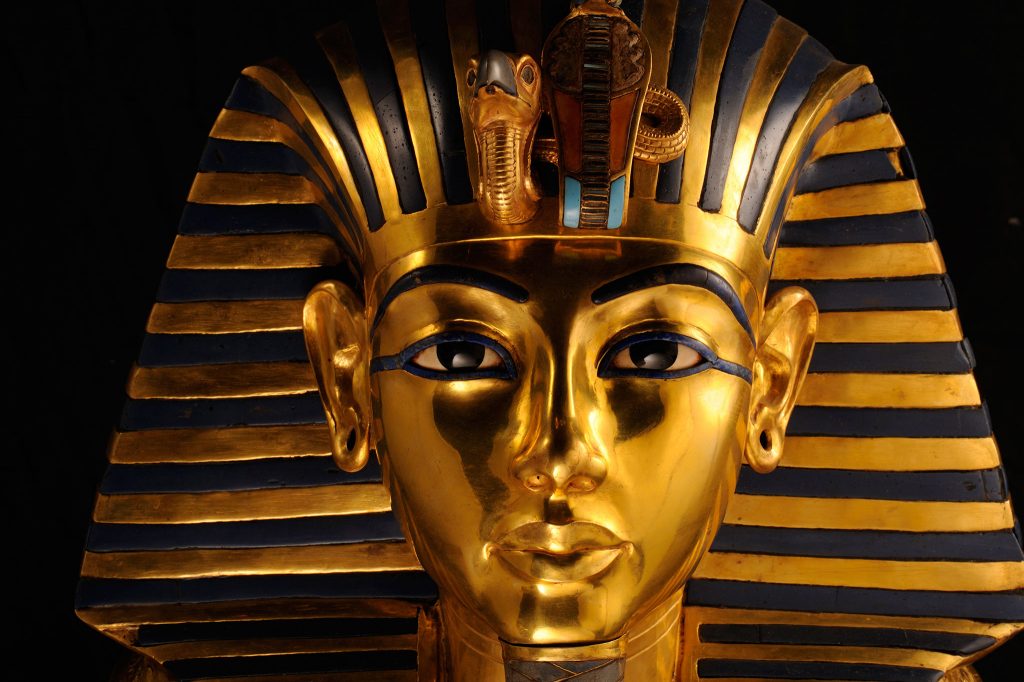Thanks to modern technology, the examination and research into mummified bodies and artifacts from ancient Egypt have answered many questions for scientists and historians alike. What was the culture of these ancient people? Who were their leaders? And what was the process and purpose of mummification? In the twentieth century, the tomb of King Tutankhamen was discovered, and that discovery has answered many of these questions. Thanks to the discoveries of the Ancient Egyptian’s burials of their kings, particularly that of King Tutankhamen, we have learned more and more about the Ancient Egyptian’s history and traditions when it comes to laying the dead to rest.

Scientists and archaeologists say that King Tutankhamen became king at the very young age of nine. However, he may have been no more than a puppet ruler, and the true power behind the throne was said to belong to a man who may have been related to Tut named Ay. Young Tut was a physically frail youth. Through the examination of his body, scientists have found malformations in his feet, and they suspect that the young man had walked with a cane.1 Though he was depicted as fighting in battles and slaying enemies in drawings on the walls of his tomb, there is no actual evidence that this young man participated in any actual battles. However, scholars believe that these depictions merely represent an extension of Tut’s power. It was believed that he married his half-sister, Anthesenpaaton, who was also very young. Though the two had not produced any known heirs, the bodies of two babies were found buried in Tut’s tomb. Archaeologists believe these babies may have been the children of young Tut and his queen.2 He reigned during a period of time known as the New Kingdom. At the young age of eighteen, Tut’s short life and reign over Ancient Egypt had come to an end. The exact cause of Tut’s death remains a mystery; however, scientists believe it may be connected with an infection spread by a broken leg.3
In 1922, the tomb of King Tut was discovered. This finding helped give archaeologists an understanding of the wealth of Egyptian civilization, especially for those living in the upper class. The value of the gold and treasure found in King Tut’s tomb, as was the case for treasures found in other areas of ancient Egypt, surpass that of many others discovered from ancient times. It also has given scientists and researchers much insight into the history, tradition, and science behind the process and purpose of mummification.4
Scholars have discovered that mummifying bodies was tied to the ancient Egyptians’ belief about the afterlife. Egyptians believed that the body was not just a corpse after death, but a resting place for the soul. Osiris, the god of the resurrection and a very respected god to the Egyptians, would judge the soul of the dead.5 Because the Egyptians believed the soul would move on, King Tut’s final resting place was filled with tools and items that the King might need in the afterlife. It contained artifacts such as clothing, musical instruments, jewelry, lamps, chairs, and baskets with food and wine. In addition to the tomb itself, much has been discovered from bodies that were laid to rest so many years ago, including the body of King Tut. The success of the preservation can be accredited to the detail that the ancient Egyptians provided during the process of mummification. Through many years of research and observation, scientists and archaeologists have found that this important practice evolved over time, but it has followed the same basic instructions and procedures.6 After his death, all of Tut’s organs were removed from the body, except the heart, and placed into containers called Canopic Jars. Afterwards, Tut’s body was then covered in a mixture called natron, which consisted of salts that helped inhibit bacterial activity and dehydrate the body. After a little over a month, the mixture of salts was removed from Tut’s body and his cavities were filled with cloth containing resin to give the corpse its shape back. Only after this was the body wrapped with linen, giving it the classic “mummy” appearance. Tut was then placed in a solid gold coffin, and the coffin was then placed in his tomb.7
Traditionally, it was only emperors, kings, and members of the upper class who were mummified, but as time progressed it became a tradition for many members of this ancient society.8
However, because Tut was a king, his resting place was filled with ancient artifacts and treasures in addition to his mummified corpse. Although his reign, and his life, were cut very short, the ancient Egyptians left more than a final resting place for the boy King’s soul when they laid him to rest: they left us, the people of the 21st century, with answers.
- Phillip A. Mackowiak, Diagnosing Giants:Solving the Medical Mysteries of Thirteen Patients Who Changed the World (Oxford: Oxford University Press, 2013), 3. ↵
- Salem Press Biographical Encyclopedia, January 2015, s.v. “Tutankhamen,” by Donald C. Simmons. ↵
- Salem Press Biographical Encyclopedia, January 2015, s.v. “Tutankhamen,” by Donald C. Simmons. ↵
- G. Elliot Smith, Tutankhamen and the Discovery of His Tomb (Routledge: Hoboken, 2013), 1. ↵
- E. A. Wallis Budge, Egyptian Religion : Egyptian Ideas of the Future Life, Routledge Revival (London: Rutledge, 2013), 41. ↵
- Salem Press Encyclopedia of Science, January 2015, s.v. “Mummification,” by James L. Robinson ↵
- Salem Press Biographical Encyclopedia, January 2015, s.v. “Tutankhamen,” by Donald C. Simmons. ↵
- George Hart, Ancient Egypt (New York: DK Publication, 2008), 1. ↵



87 comments
Belene Cuellar
I have heard and learned about King Tut and his short rule over Egypt. Except in all of my lessons my teachers always depicted him as a strong and powerful ruler, not a frail young boy with weak feet. It’s interesting to see the reality of King Tut and his very short rule as king. I’m actually very interested in how he spent most of his days considering his condition he probably couldn’t do much anyways. The author did a good job in organizing this article and covering the main points. This was truly an interesting article and I learned so much from it.
Mario Sosa
I don’t know anyone who doesn’t recognize King Tutankhamun’s famous golden sarcophagus. I find it to be marvelous how modern day technology has the ability to give us so many details about King Tutankhamun. With so much information we were able to find out about King Tutankhamun, it’s a shame that many of the ancient tombs, especially those from the Old Kingdom, have already been raided and its contents now forever lost. Very great article, nice work!
Cristian Medina-Lopez
I thought this article was very well written with a lot of informative facts that helped me enhance my knowledge on Egyptian history. I found it interesting how out of all ways King Tutankhamen could have died, scientist believe it was an infection from his broken leg. I find this astonishing because of what much more he could have done if he would have lived on longer.
Crystalrose Quintero
I think its so interesting to find mummification of a body thousands of years old and still predict that that person may have used a cane. It was so interesting to provide information as to how mummification occurs and how it happened in tut’s death; again, considering the years that have passed. The conclusion was such a good closing by indicating that they left answers for us.
Alejandra Mendez
This was a very interesting and informative article. I had some knowledge of King Tut from what I learned in high school history classes, but lessons about this topic never went into depth and did not teach me as much as this article did. I never knew how young he really was when he became king. Very interesting and admirable that even though he wasn’t really seen as a king and more of a “puppet ruler” as mentioned in the article, he was still buried and mummified like any king would have been. Very well written and thought filled article.
Karla Chavana
King Tutankhamen: Although I have heard of King Tut quite a bit, I have never heard of the babies found in his tomb, or that the possible reason of his death could’ve originated from an infection from a broken leg. I know that the pyramid in which he was found wasn’t as voluminous as others; however, the biggest treasure was on the inside. I cannot help but assume that King Tut was cherished by his people, whether it was him as the ruler or just a puppet. This was a great article that taught me a thing or two!
Eduardo Foster
Great article! Never heard in my life about King Tutankhamun. It’s amazing that he ruled Egypt since such a young age! That in today’s could not be accepted. It also very interesting the information provided in his corpse. I didn’t neither know the process they had to go through under mummification! Great article keep it up with the good work!
Cherice Leach
I have definitely heard of King Tut before but what I never knew was that he was just a boy! That’s crazy how during that time the kings and queens were picked at such a young age. It’s also crazy that they might have had children even they were still children. Our society today would not accept that kind of culture… The last thing that I found really cool was the praise and treasure that these deceased Egyptians would receive. I understand they believed in afterlife but it’s still a weird aspect to understand.
Emily Jimenez
This is a great article! I had always heard of the great King Tut, but I never knew why he was so famous. As a matter of fact, I didn’t know anything about him that was mentioned in this article. It was fascinating to read that he had malformations in his feet but yet he still became king at the age of nine! I think it would be nice if you explained who Ay was so that we just don’t have a random name with no facts.
Josselyn Arrieta-Meraz
A 9 year old king and ruling ancient Egypt… I would have never imagined. This article was fascinating from beginning to end, not only was I informed about King Tut’s life but a small look into the actual process of mummification, to think of what goes into preserving a body. Learning about their beliefs in the afterlife and the treasure left behind for their afterlife really gets you thinking how different of a world that was in past history.